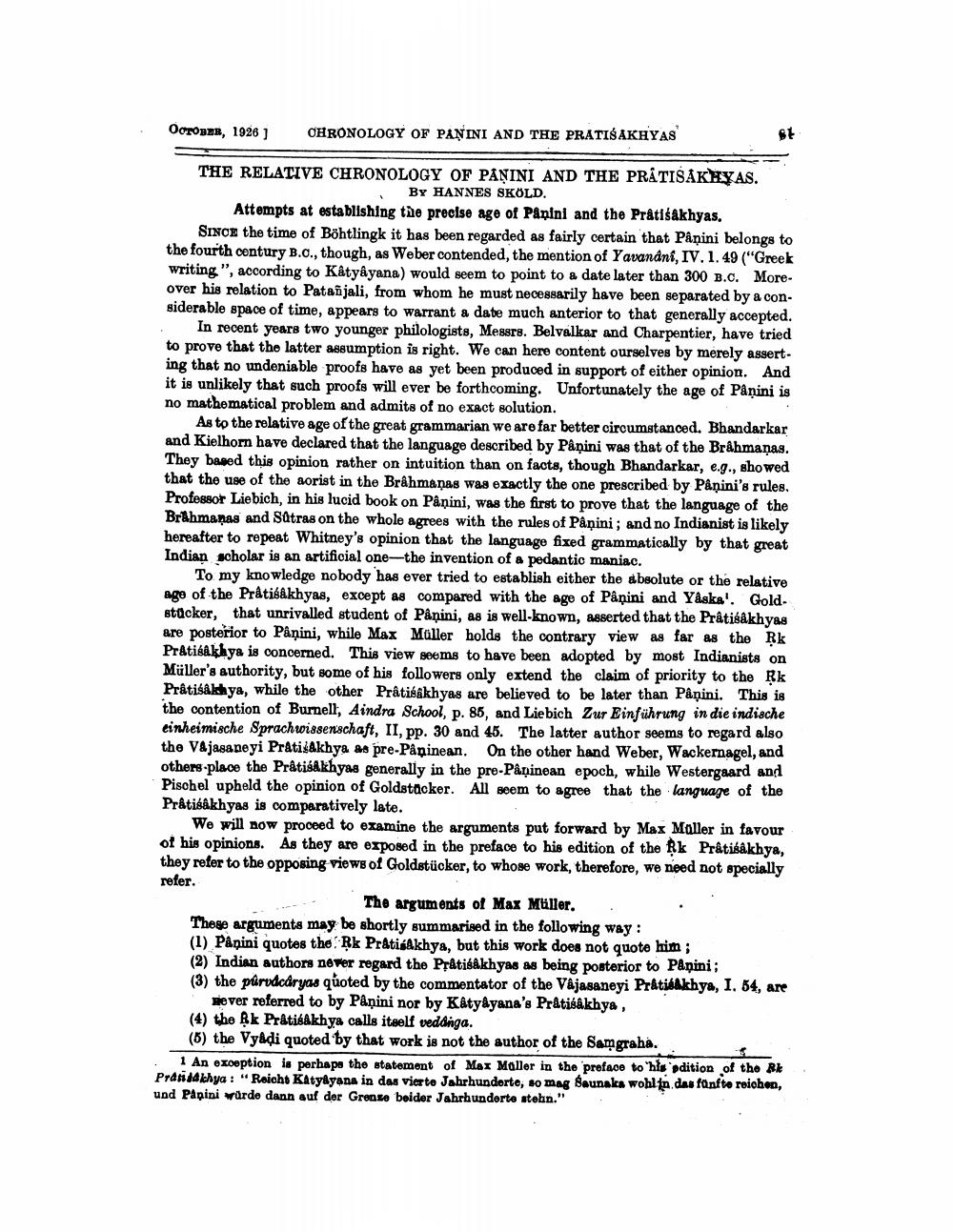________________
OCTOBER, 1926 )
CHRONOLOGY OF PANINI AND THE PRATISAKHYAS
THE RELATIVE CHRONOLOGY OF PANINI AND THE PRÁTISAKEYAS.
BY HANNES SKÖLD. Attempts at establishing the precise age of Papini and the Prátisakhyas. SINCE the time of Böhtlingk it has been regarded as fairly certain that Pånini belongs to the fourth century B.C., though, as Weber contended, the mention of Yavandní, IV. 1. 49 (“Greek writing", according to Katyayana) would seem to point to a date later than 300 B.C. More. over his relation to Patanjali, from whom he must necessarily have been separated by a considerable space of time, appears to warrant a date much anterior to that generally accepted.
In recent years two younger philologists, Messrs. Belvalkar and Charpentier, have tried to prove that the latter assumption is right. We can here content ourselves by merely asserting that no undeniable proofs have as yet been produced in support of either opinion. And it is unlikely that such proofs will ever be forthcoming. Unfortunately the age of Påņini is no mathematical problem and admits of no exact solution.
As to the relative age of the great grammarian we are far better circumstanced. Bhandarkar and Kielhorn have declared that the language described by Panini was that of the Brahmaņas. They based this opinion rather on intuition than on facts, though Bhandarkar, e.g., showed that the use of the aorist in the Brahmanas was exactly the one prescribed by Påņini's rules. Professor Liebich, in his lucid book on Panini, was the first to prove that the language of the Brahmanas and Stras on the whole agrees with the rules of Pånini; and no Indianist is likely hereafter to repeat Whitney's opinion that the language fixed grammatically by that great Indian scholar is an artificial one-the invention of a pedantic maniac.
To my knowledge nobody has ever tried to establish either the absolute or the relative Age of the Prâtibakhyas, except as compared with the age of Påņini and Yaska'. Gold. stacker, that unrivalled student of Panini, as is well-known, asserted that the Prátisakhyas are posterior to Pånini, while Max Müller holds the contrary view as far as the Rk PrAtisakhya is concerned. This view seems to have been adopted by most Indianists on Müller's authority, but some of his followers only extend the claim of priority to the Rk Prâtisakhya, while the other Prâtisakhyas are believed to be later than Panini. This is the contention of Burnell, Aindra School, p. 85. and Lie bich Zur Einführung in die indische einheimische Sprachwissenschaft, II, pp. 30 and 45. The latter author seems to regard also the VAjasaneyi PrátisAkhya as pre-Påninean. On the other hand Weber, Wackernagel, and others place the Prátisakhyas generally in the pre-Paninean epoch, while Westergaard and Pischel upheld the opinion of Goldstacker. All seem to agree that the language of the Prátisakhyas is comparatively late.
We will now proceed to examine the arguments put forward by Max Moller in favour of his opinions. As they are exposed in the preface to his edition of the RK Prátisakhya, they refer to the opposing views of Goldstücker, to whose work, therefore, we need not specially refer.
The arguments of Max Müller. These arguments may be shortly summarised in the following way: (1) Panini quotes the Rk PratisAkhya, but this work does not quote him ; (2) Indian authors never regard the Prátisakhyas as being posterior to Panini; (3) the půrudcdryas quoted by the commentator of the Vâjasaneyi PratibAkhya, I. 54, are
never referred to by Påņini nor by Katyayana's Prátisákhya, (4) the Rk PrátisAkhya calls itself vedanga. () the Vy&di quoted by that work is not the author of the Samgraha.
1 An exception is perhaps the statement of Max Maller in the preface to his pdition of the Rk Prasida chya : "Reicht Katyayana in das vierte Jahrhunderte, ko mag Saunaka wohl in das fanfte reichen, und Papini würde dann auf der Grenze beider Jahrhunderte stehn."




